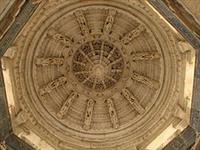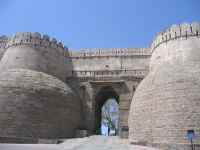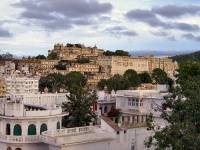
Forty miles (60km) north of Udaipur are the Jain Temples of Ranakpur. It is the largest temple complex of its kind in India, and boasts some truly staggering marble work - easily on a par with any in Asia. The main temple was built in 1439, and is dedicated to the first tirthankara Adinath, whose image is enshrined in its central sanctuary. The temple is two or three storeys high in parts, and its roof, topped with five large shikharas, undulates with tiny spires that crown the small shrines to Jain saints lining the temple walls. Within are 1444 pillars, each sculpted with unique and intricate designs, and dissecting the 29 halls. The carving on the walls, columns and the domed ceilings is superb. Friezes depicting the life of the tirthankara are etched into the walls, while musicians and dancers have been modelled out of brackets between the pillars and the ceiling. While exploring the temples at Ranakpur, visitors may see Jain monks walking about with masks on their faces to avoid eating insects. The most important teaching of Jainism is 'Ahimsa', meaning non-violence, and this is applied to all sentient beings. Many monks also carry a brush to sweep surfaces to avoid standing on bugs. Ranakpur's isolated position means it is not on the major tourist trail, but it makes a good stop for those travelling between Jaipur and Udaipur.
Address : Ranakpur, Pali district
Website : www.ranakpurtemple.com/

Kumbhalgarh is a massive Mewar fortress built in the 15th century, with seven heavily fortified gateways and a perimeter wall that extends a staggering 22 miles (36km); possibly the second longest continuous wall in the world. Inside this intimidating complex there are more than 360 temples (300 ancient Jain and the rest Hindu) in addition to the main palace. The fortress has immense sentimental significance for local inhabitants because it is the birthplace of Mewar's legendary king, Maharana Pratap. Needless to say, one can spend hours exploring this architectural and historical playground, and those who enjoy climbing will find many opportunities. The views from the many vantage points of this fortress are astounding.Legend has it that the maharana who built Kumbhalgarh encountered some construction difficulties and consulted a spiritual advisor who decreed that a voluntary human sacrifice would enable the project. A volunteer was eventually found and the position of the decapitated head and body signalled where building should go forward. A shrine to this unknown volunteer can still be found in the main gate.Kumbhalgarh is situated about 50 miles (82km) to the northwest of Udaipur and the drive will take about one and a half hours, making it a manageable and rewarding excursion. The fort is extremely well-maintained and the fact that it is a little remote ensures that there are seldom crowds, despite how astounding an attraction it is. There is a sound and light show in the evenings but it is conducted in Hindi.
Address : Qila Kumbhalgarh, Rajasthan 313325
Website : www.kumbhalgarhfortwalk.com/

The white walls of Udaipur's Lake Palace soar above the peaceful waters of Lake Pichola, topped by ornamental battlements and turrets. The sprawling palace has been developed by successive maharanas since the foundation of Udaipur in 1559. These days, part of the palace is home to the current maharana, a section of it is a first-class hotel (with the best restaurant in the city), and the remainder is a museum.The approach to the City Palace is through the Elephant Gate, Hati Pol. The Great Gate (Bara Pol) leads to the first court, where eight carved arches mark the spot where the rulers were once weighed against gold or silver, the equivalent value of which was then distributed among the poor. Beyond the Tripolia Gate is the arena where the elephant tug-of-war competitions were staged, past which are a series of courtyards, overlapping pavilions, terraces, corridors and hanging gardens.The Krishna Vilas honours a 19th-century Udaipur princess, who poisoned herself to avoid the dilemma of choosing a husband from the two rival households of Jodhpur and Jaipur. Its walls display miniature paintings portraying royal processions, festivals and hunting parties. Further along, a glass mosaic gallery contains superb portraits and stained glass, and offers a wonderful panoramic view of the city below. Set into the walls of the 17th-century Mor Chowk are brilliant mosaics of three peacocks showing the three seasons: summer, winter and monsoon. Perhaps the most splendid rooms in the palace are the women's quarters, Zenana Mahal, with their ornate alcoves, balconies and coloured windows.Udaipur's Lake Palace really does have a storybook quality to it - both in terms of its looks and its history - and it is rightly considered by all and sundry to be one of India's stellar tourist attractions.
Address : Pichola, Udaipur

Travel Guide powered by Word Travels, copyright © 2023 Globe Media Ltd. By its very nature information in this travel guide is subject to change at short notice and travellers are urged to verify information on which they're relying with the relevant authorities. Neither Globe Media Ltd nor Travel Vogue can accept any responsibility for any loss or inconvenience to any person as a result of information contained above.